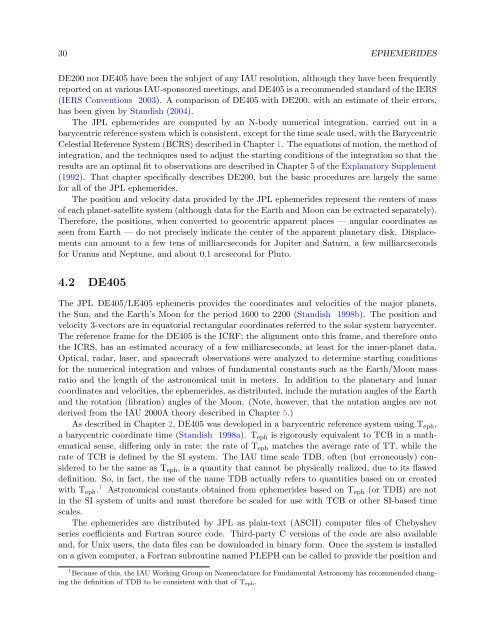USNO Circular 179 - U.S. Naval Observatory
USNO Circular 179 - U.S. Naval Observatory
USNO Circular 179 - U.S. Naval Observatory
Create successful ePaper yourself
Turn your PDF publications into a flip-book with our unique Google optimized e-Paper software.
30 EPHEMERIDES<br />
DE200 nor DE405 have been the subject of any IAU resolution, although they have been frequently<br />
reported on at various IAU-sponsored meetings, and DE405 is a recommended standard of the IERS<br />
(IERS Conventions 2003). A comparison of DE405 with DE200, with an estimate of their errors,<br />
has been given by Standish (2004).<br />
The JPL ephemerides are computed by an N-body numerical integration, carried out in a<br />
barycentric reference system which is consistent, except for the time scale used, with the Barycentric<br />
Celestial Reference System (BCRS) described in Chapter 1. The equations of motion, the method of<br />
integration, and the techniques used to adjust the starting conditions of the integration so that the<br />
results are an optimal fit to observations are described in Chapter 5 of the Explanatory Supplement<br />
(1992). That chapter specifically describes DE200, but the basic procedures are largely the same<br />
for all of the JPL ephemerides.<br />
The position and velocity data provided by the JPL ephemerides represent the centers of mass<br />
of each planet-satellite system (although data for the Earth and Moon can be extracted separately).<br />
Therefore, the positions, when converted to geocentric apparent places — angular coordinates as<br />
seen from Earth — do not precisely indicate the center of the apparent planetary disk. Displacements<br />
can amount to a few tens of milliarcseconds for Jupiter and Saturn, a few milliarcseconds<br />
for Uranus and Neptune, and about 0.1 arcsecond for Pluto.<br />
4.2 DE405<br />
The JPL DE405/LE405 ephemeris provides the coordinates and velocities of the major planets,<br />
the Sun, and the Earth’s Moon for the period 1600 to 2200 (Standish 1998b). The position and<br />
velocity 3-vectors are in equatorial rectangular coordinates referred to the solar system barycenter.<br />
The reference frame for the DE405 is the ICRF; the alignment onto this frame, and therefore onto<br />
the ICRS, has an estimated accuracy of a few milliarcseconds, at least for the inner-planet data.<br />
Optical, radar, laser, and spacecraft observations were analyzed to determine starting conditions<br />
for the numerical integration and values of fundamental constants such as the Earth/Moon mass<br />
ratio and the length of the astronomical unit in meters. In addition to the planetary and lunar<br />
coordinates and velocities, the ephemerides, as distributed, include the nutation angles of the Earth<br />
and the rotation (libration) angles of the Moon. (Note, however, that the nutation angles are not<br />
derived from the IAU 2000A theory described in Chapter 5.)<br />
As described in Chapter 2, DE405 was developed in a barycentric reference system using Teph,<br />
a barycentric coordinate time (Standish 1998a). Teph is rigorously equivalent to TCB in a mathematical<br />
sense, differing only in rate: the rate of Teph matches the average rate of TT, while the<br />
rate of TCB is defined by the SI system. The IAU time scale TDB, often (but erroneously) considered<br />
to be the same as Teph, is a quantity that cannot be physically realized, due to its flawed<br />
definition. So, in fact, the use of the name TDB actually refers to quantities based on or created<br />
with Teph. 1 Astronomical constants obtained from ephemerides based on Teph (or TDB) are not<br />
in the SI system of units and must therefore be scaled for use with TCB or other SI-based time<br />
scales.<br />
The ephemerides are distributed by JPL as plain-text (ASCII) computer files of Chebyshev<br />
series coefficients and Fortran source code. Third-party C versions of the code are also available<br />
and, for Unix users, the data files can be downloaded in binary form. Once the system is installed<br />
on a given computer, a Fortran subroutine named PLEPH can be called to provide the position and<br />
1 Because of this, the IAU Working Group on Nomenclature for Fundamental Astronomy has recommended chang-<br />
ing the definition of TDB to be consistent with that of Teph.


